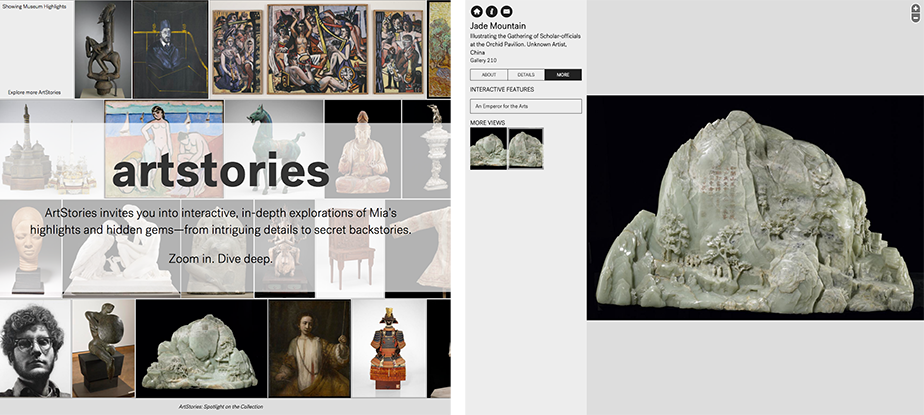A Griot is a west-african storyteller. From the Francis Bebey book, African Music, A People’s Art, he writes:
“The West African griot is a troubadour, the counterpart of the medieval European minstrel… The griot knows everything that is going on… He is a living archive of the people’s traditions.”
As part of Minneapolis Institute of Art’s African Galleries reinstallation of 2013, Mia was tasked with creating a toolset to be reused and shared amongst the museum community, based on open-source ideals. Thus was born Griot, a free, web-based software toolkit hosted on Github to help museums quickly create iPad-based interpretive and storytelling experiences. Visitors can perform a deep dive on aspects of the art (such as the interior of a vase, or the verso of a painting) while sitting in front of the art, or probe deeper into what they saw from their own device at at later time. Users can zoom into minute aspects of the art, the brushstrokes and other details not viewable from behind glass. To go even deeper, they can view video and read engaging stories about the provenance of the object, and learn more about the artists and their culture. The software is responsive and can be used on any device, from smartphone to large touchscreen.
ArtStories is Mia’s implementation of the software and can be found nestled into comfortable benches and atop cubes sprinkled about the galleries. It has also been implemented by the deYoung in San Francisco for Embodiments: Masterworks of African Figural Sculpture; and at the St. Louis Art Museum for Navigating the River: George Caleb Bingham and the West exhibitions.
ROLES • User Interface Design • User Experience Design • Information Architecture • Coined the software name, Griot
The software was evaluated by the audience research and evaluation firm Audience Viewpoints and conducted by renown researcher Kate Haley Goldman (currently Senior Staff of the Center for Interactive Learning, a non-profit founded by the Space Science Institute). The following is from their report: • Mia visitors will use technology in the galleries for interpretation and context of the art. They will spend a significant amount of time with the technology, and they will discuss and read aloud as they do so. Their primary focus remains the art and learning more about it. • During the 10 minutes on average visitors spent in the African Galleries, they were unequivocally positive about what they saw and their most memorable items were the art objects themselves. Technology in the galleries served neither as a driver nor a distractor, but a lens through which they could gain insight about the art. • The strong use of technology does not detract from visitor focus on the art. It seems despite the visitors’ ambivalence about the technology, in the end the technology was transparent, allowing them to focus on the collections and their context. When visitors were leaving the gallery, the descriptions of their visit and highlights were almost exclusively about the art. • Visitors who used ArtStories explored more of Mia. It is quite rare in museums that a single interactive will regularly change the path of a museum visitor’s experience, but some ArtStories visitors were so inspired by the stories they read, they went on to find those objects and galleries: 27% explored new objects, 21% explored new galleries, and 48% used multiple ArtStories locations. • One third of the ArtStories users recalled specific stories weeks after their visit.
A letter from a mother regarding her special needs son using ArtStories: “I visited Mother’s Day with my two children and partner. My son, 14, has unique needs and experiences life differently than most. Mother’s Day at the MIA used to be our day to visit, but as my son great and his behavior became more noticeable, our visits to MIA stopped. My daughter, now 18, requested we try MIA for Mother’s Day this year. How could I resist? [snip] As I looked around the exhibit area, I noticed a bench with 2 iPads. I called my son to the exhibit area and showed him the iPads. He immediately began to engage with the images and read all the information about the artifacts. Then he did something amazing. He got up and found the actual artifacts in the exhibit area!!! This kind of exploration has never happened in the past. Even better, he remembered specific details about the artifacts and shared that information with his sister and me. I understand you may have not anticipated how meaningful this is for both my son and the rest of his family. The iPad became a point of entry for him that is so powerful it completely transformed our family experience at the Institute of Art. We were able to stay more than one hour and enjoy looking at and reading about the beautiful artifacts. Words of “thank you“ are not enough. My sense of gratitude runs deeper than you can imagine when I watch my son experience art in such a way that rivals the most avid art lover. I believe your staff is using technology in such a way that allows people like my son to access and appreciate art in such a way that is not possible on their own. Thank you, thank you, thank you!!! A most grateful mother, Heidi Graf”







